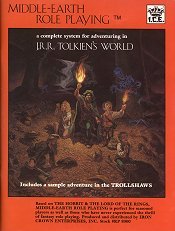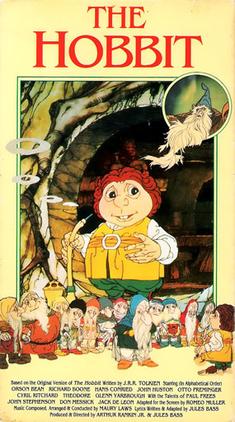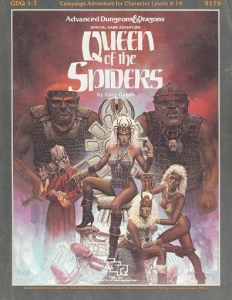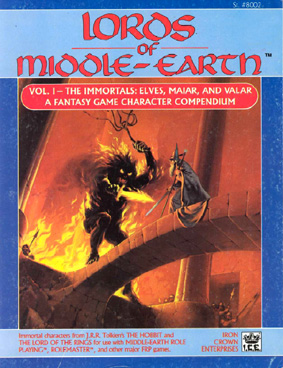
Trolls of the Misty Mountains is a supplement published by Iron Crown Enterprises (ICE) in 1986 for the fantasy role-playing game Middle-earth Role Playing (MERP), which is itself based on the works of J.R.R. Tolkien.

Trolls of the Misty Mountains is a supplement published by Iron Crown Enterprises (ICE) in 1986 for the fantasy role-playing game Middle-earth Role Playing (MERP), which is itself based on the works of J.R.R. Tolkien.
In The Hobbit , Tolkien's precursor to The Lord of the Rings , Bilbo Baggins and his companions encounter some of the denizens that live under the Misty Mountains.
This book contains three adventures that take place in the vestiges of the former kingdom of Rhudaur that once lay against the eastern side of the Misty Mountains. The time is 1600 years after the defeat of Sauron by the Last Alliance of Elves and Men, and 1500 years before the events described in The Hobbit and The Lord of the Rings. It includes a set of three adventures, each with an increasing difficulty over the previous one. [1]
The adventurers are hired to reconnoitre the route of a proposed road to be built between the keeps of Daenos and Elnost, rooting out any potential dangers such as trolls and orcs. To do this, they must complete three adventures: [2]
ICE published the licensed game Middle Earth Role-Playing in 1982, and then released many supplements for it over the next 17 years, until the Tolkien Estate withdrew their license in 1999. Trolls of the Misty Mountains was written by John Cresswell and Mike Cresswell, with a cover by Daniel Horne, cartography by Jessica Ney, and illustrations by Denis Loubet, and was published by Iron Crown Enterprises in 1986 as a 32-page book. [3] I.C.E. revisited this area in later publications including Phantom of the Northern Marches (1986), Dark Mage of Rhudaur (1989), and Arnor (1994). [2]
Some reviewers were generally dismissive of this book, finding it lacked originality:
Denis Beck, in the April 1987 edition of Casus Belli (Issue #37), disagreed, calling theses adventures "very classic." His only complaint was "the meagreness of the historical background, which risks confusing a beginner gamemaster." [5]
Thorin Oakenshield is a fictional character in J. R. R. Tolkien's 1937 novel The Hobbit. Thorin is the leader of the Company of Dwarves who aim to reclaim the Lonely Mountain from Smaug the dragon. He is the son of Thráin II, grandson of Thrór, and becomes King of Durin's Folk during their exile from Erebor. Thorin's background is further elaborated in Appendix A of Tolkien's 1955 novel The Return of the King, and in Unfinished Tales.
In the fantasy of J. R. R. Tolkien, the Dwarves are a race inhabiting Middle-earth, the central continent of Arda in an imagined mythological past. They are based on the dwarfs of Germanic myths who were small humanoids that lived in mountains, practising mining, metallurgy, blacksmithing and jewellery. Tolkien described them as tough, warlike, and lovers of stone and craftsmanship.

Middle-earth Role Playing (MERP) is a 1984 tabletop role-playing game based on J. R. R. Tolkien'sThe Lord of the Rings and The Hobbit under license from Tolkien Enterprises. Iron Crown Enterprises (I.C.E.) published the game until they lost the license on 22 September 1999.

Iron Crown Enterprises (ICE) is a publishing company that has produced role playing, board, miniature, and collectible card games since 1980. Many of ICE's better-known products were related to J. R. R. Tolkien's world of Middle-earth, but the Rolemaster rules system, and its science-fiction equivalent, Space Master, have been the foundation of ICE's business.
Trolls are fictional characters in J. R. R. Tolkien's Middle-earth, and feature in films and games adapted from his novels. They are portrayed as monstrously large humanoids of great strength and poor intellect. In The Hobbit, like the dwarf Alviss of Norse mythology, they must be below ground before dawn or turn to stone, whereas in The Lord of the Rings they are able to face daylight.

The Hobbit is a 1977 American animated musical television special created by Rankin/Bass and animated by Topcraft. The film is an adaptation of the 1937 book of the same name by J. R. R. Tolkien; it was first broadcast on NBC in the United States on Sunday, November 27, 1977. The teleplay won a Peabody Award. The Tolkien scholar Douglas A. Anderson called the adaptation "execrable".

Day of Al'Akbar is an Advanced Dungeons & Dragons adventure module written by Allen Hammack and published by TSR inc. in 1986. The module consists of a forty-page booklet with a large color map and an outer folder. It bears the Dungeons & Dragons code I9, I meaning intermediate and 9 for module 9 in that series.

Space Master is a science fiction role-playing game produced by Iron Crown Enterprises (ICE) in 1985.
The DL series is a series of adventures and some supplementary material for the Advanced Dungeons & Dragons role playing game. These modules along with the Dragonlance Chronicles trilogy of novels, which follow one possible adventure series through the modules, were the first published items that established the Dragonlance fictional universe. The original DL series was released from 1984 to 1986, with the final two modules added to it in 1988. In the 1990s these roleplaying adventures from the original series were collected and revised for 2nd Edition AD&D as the three DLC Dragonlance Classics modules. There were also versions of the module series released in 1999, 2000 and 2006.

The Veiled Society is an adventure module for the Basic Rules of the Dungeons & Dragons fantasy role-playing game published in 1984. The adventure's product designation is TSR 9086.

Queen of the Spiders is an adventure module for the Dungeons & Dragons fantasy role-playing game. It was published by TSR, Inc. in 1986 and is a compilation of seven previous related modules, often referred to as a "supermodule." Together, the seven adventures form an integrated campaign that begins in the World of Greyhawk, continues underground into the Underdark, and concludes in the Demonweb Pits, the abyssal lair of the demonic goddess Lolth. The campaign was originally intended for use with the rules from the first edition of Advanced Dungeons & Dragons.

Lord of the Rings Adventure Game is a role-playing game based on the writings of J. R. R. Tolkien under license from Tolkien Enterprises. Iron Crown Enterprises (I.C.E.) published the game until they lost the license on 22 September 1999.

Northern Mirkwood: The Wood-Elves Realm is a 1983 fantasy role-playing game supplement published by Iron Crown Enterprises for Middle-earth Role Playing.

Lords of Middle-earth, Volume I is a 1986 fantasy role-playing game supplement published by Iron Crown Enterprises for Middle-earth Role Playing.

Griffin Island is a boxed tabletop role-playing game supplement for RuneQuest. Originally published by Chaosium in 1981 as Griffin Mountain, a set of adventures set in the world of Glorantha, this edition was published in 1986 by The Avalon Hill Game Company as part of its third edition RuneQuest rules set. It was written by Rudy Kraft, Jennell Jaquays, Greg Stafford, and Sandy Petersen. Griffin Island contained role-playing material to help gamemasters design adventures in the setting. It received positive reviews in game periodicals including Casus Belli, White Dwarf, Dragon, Space Gamer/Fantasy Gamer, The Games Machine, and Games International.

Erech and the Paths of the Dead is a supplement published by Iron Crown Enterprises (ICE) in 1985 for the fantasy role-playing game Middle-earth Role Playing, which is itself based on the works of J.R.R. Tolkien.

Send in the Clones is an adventure written by Allen Varney and Warren Spector, published in 1985 by West End Games for the light-hearted science-fiction role-playing game Paranoia. It was written by Allen Varney and Warren Spector, and consists of three short adventure scenarios involving the broadcasting star Teela O'Malley. It received positive reviews in game periodicals including White Dwarf, Casus Belli, and Different Worlds.

Lórien & The Halls of the Elven Smiths is a supplement published by Iron Crown Enterprises (ICE) in 1986 for the fantasy role-playing game Middle-earth Role Playing, which is itself based on the works of J.R.R. Tolkien.

Minas Tirith is a sourcebook published by Iron Crown Enterprises (ICE) in 1988 as part of its series "Cities of Middle-earth". The book provides details about the city of Minas Tirith for use with the game Middle-earth Role Playing (MERP), itself based on the epic trilogy Lord of the Rings by J.R.R. Tolkien.